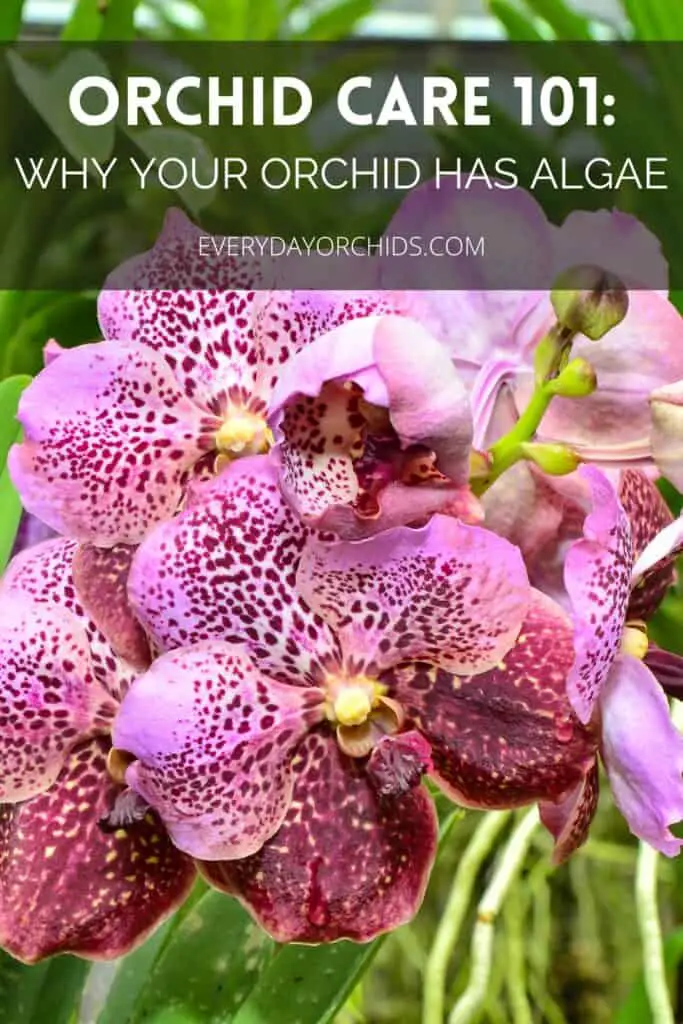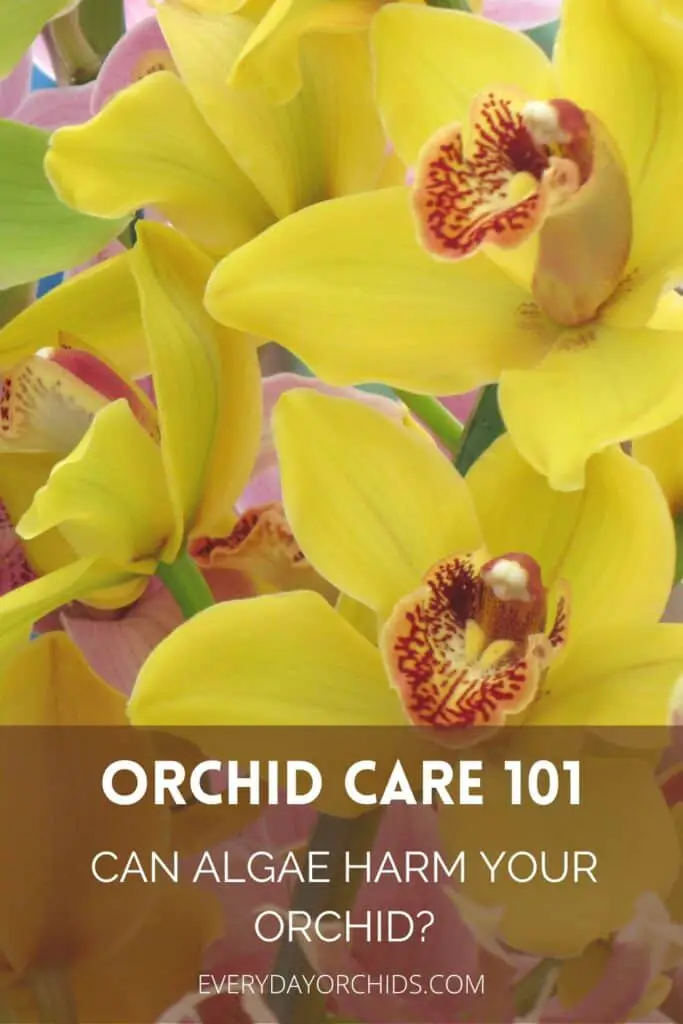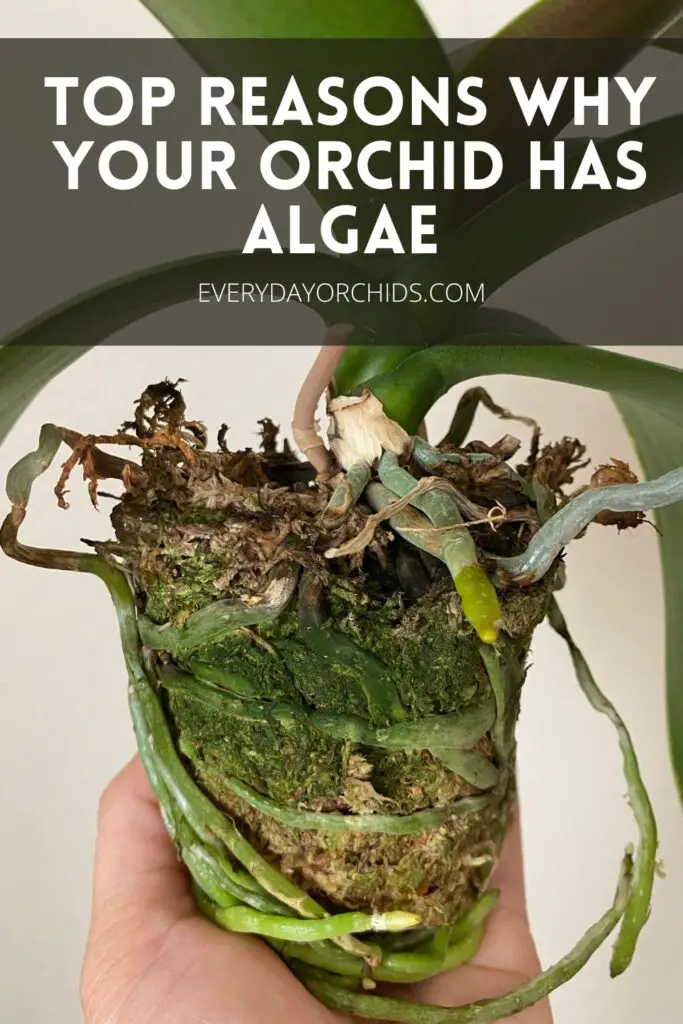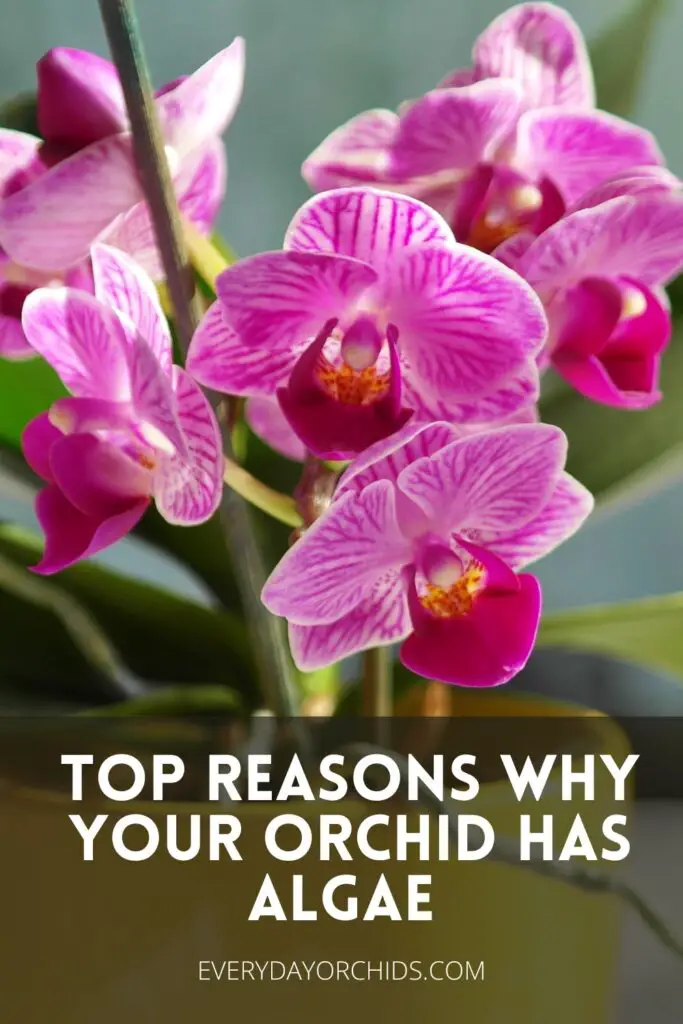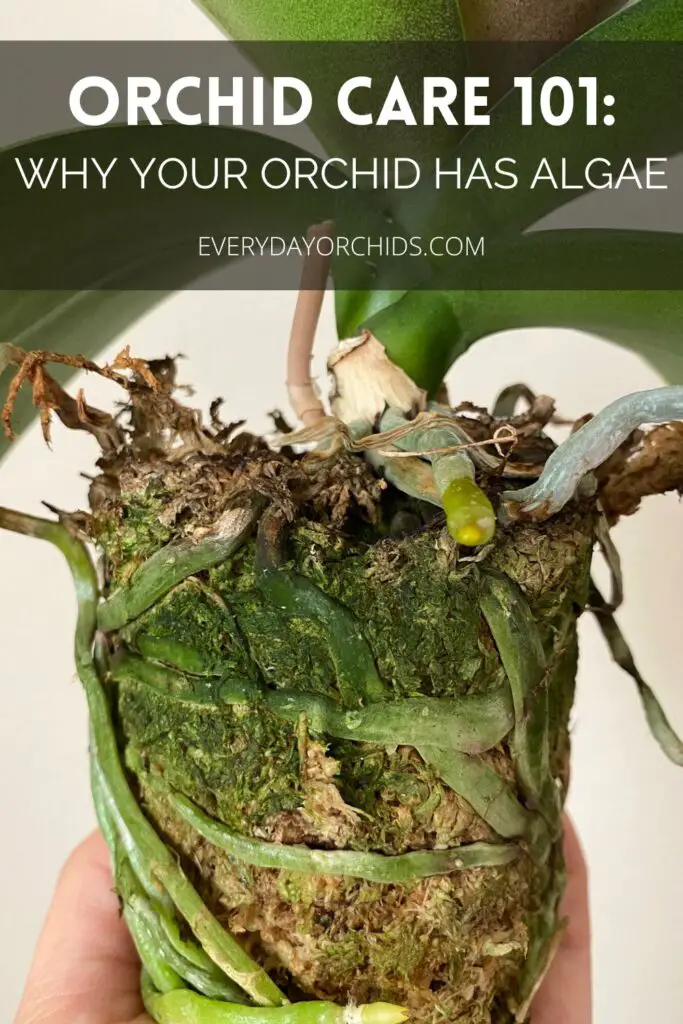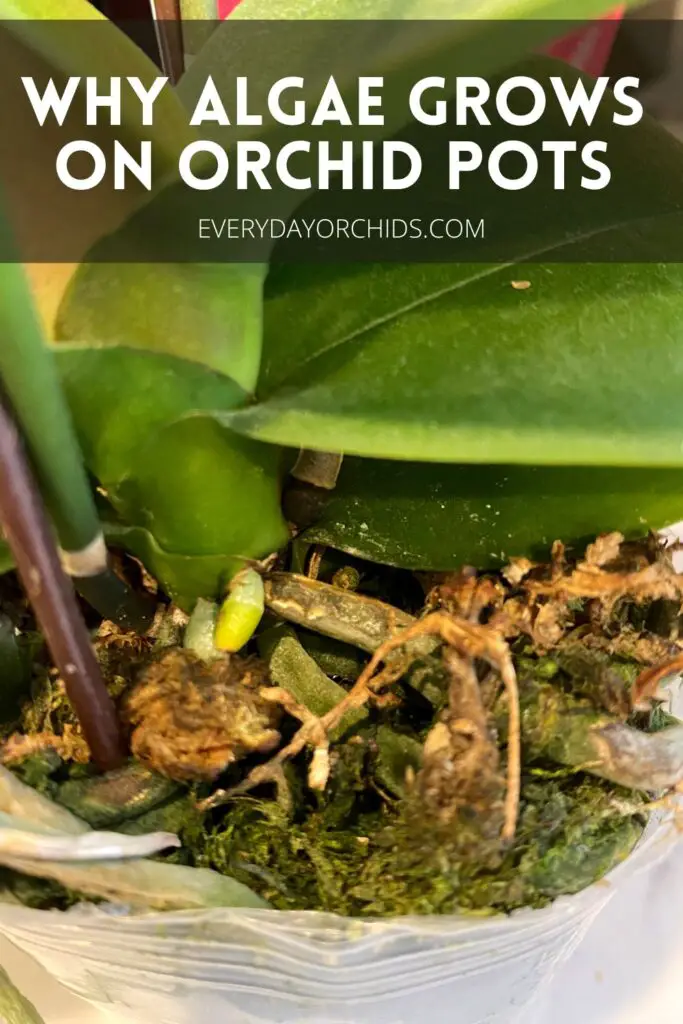Have you ever noticed a green slimy substance on your orchid roots and orchid pot and wondered what it was? This happened to me recently. I found the inside of my clear orchid pot covered in a green film. Turns out, it was algae. There was algae on the potting media too. This led me to look into the topic more and find out why algae grows on plants and orchid roots.
It turns out, algae grows when light, moisture and nutrients are present. Algae can grow on orchid roots, orchid potting media and on the pot. Most of the time, a little algae won’t hurt your plant. However, in extreme cases, algae can be harmful to orchids and may even smell bad.

In this article, I’ll go over in more detail the reasons why algae can be found on orchid roots and pots. You’ll learn whether or not algae is bad for your orchids and when it can be a problem. You’ll also learn why algae can sometimes smell bad and what to do if you find foul-smelling algae on your orchid. Keep reading to learn more.
Please note that these links are affiliate links and as an Amazon Associate, I earn from qualifying purchases. Purchases made through affiliate links in this post may generate commissions at no additional cost to you. Use this link for a discounted Amazon Prime trial. Thank you for your support!
Table of Contents
Why Does Algae Grow On Orchid Roots And Pots?
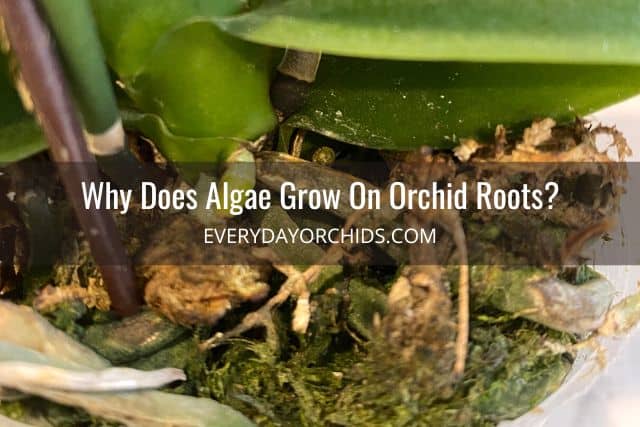
The picture above shows algae growing on my orchid’s roots and potting media, which so happened to be sphagnum moss. This discovery is what initially led me on this path to find out more about algae.
If you primarily use clear orchid pots to grow your orchids, you may also run into a situation where a green, slimy substance starts to appear in your orchid pot. Algae may be found on your orchid’s roots, the potting media or along the inside of your orchid pot.
There are a few reasons why algae grows. Algae can grow as a result of ideal growing conditions, over-fertilization, and improper sterilization or treatment. I’ll go over each of these in more detail below.
Growing Conditions
Algae growth typically occurs when there is the right combination of light, water and nutrients, or fertilizer.
Moisture is key for algae growth. This is particularly why you will see algae growing on sphagnum moss more often than orchid bark. Moss is just able to stay damp for longer periods of time.
Warm temperatures and high humidity will also facilitate algae growth. In terms of orchids, light and condensation on the inside of the pot, due to damp potting media, can lead to algae growth.
Algae growth can also be seen with orchids grown in semi-hydroponics. This is particularly true if you are using clear containers to allow light to shine through to the roots. Usually the algae will start to grow on the inside of the container and the LECA pebbles. Before long, the entire inner surface may be covered in green slime if you’re not careful.
Improper Sterilization
Another reason why algae may be found on your orchid roots and containers is due to improper sterilization of the potting media.
Usually potting media such as sphagnum moss is heat-sterilized before packaging. This is done to kill off any microorganisms, including algae spores.
However, if this is not done, algae spores may remain and can lead to algae growth in the right growing conditions. This is particularly true if you use sphagnum moss for your orchids.
That said, algae spores doesn’t always equate to algae growth. I want to stress that without the other factors present, such as light or moisture, the algae spores will stay dormant. This will be the case until the right growing conditions present themselves.
Over-Fertilization
Over-fertilization can sometimes lead to excessive algae growth. Too many available nutrients, combined with light, moisture and warmth, encourages prolific algae growth.
Orchids like weak fertilization. If you are new to orchid care, read more about how to fertilize your orchids here.
Decomposing Potting Media
Algae growth can also occur when the orchid potting media is fairly old and broken down. Decomposing potting media, combined with the presence of light and moisture, can encourage algae growth.
So if you see algae growing on the orchid’s potting media, it could be a sign that the potting media is old and needs to be replaced.
Can Algae Spread From One Plant To Another?
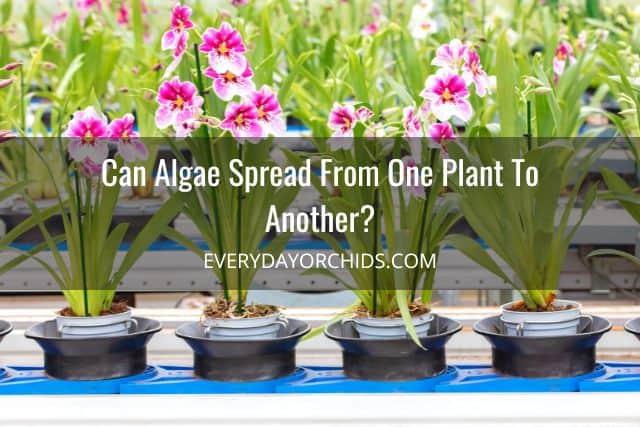
Algae can spread from one plant to another, but only under certain conditions. Algae requires wind or water to carry the algae spores from plant to plant.
This means that you may see algae spread in a greenhouse, where water runoff and high humidity may be present. You may also see algae spread in a hydroponics set-up where multiple plants share the same water system.
However, if you keep your orchids in your home, the chances of algae spreading amongst indoor orchids is slim. This is because you are likely keeping your orchids in individual pots and watering each one separately.
Unlike pests or diseases, algae will not spread between plants just because they are in close proximity. There needs to be a carrier for the algae spores, such as wind or water.
That said, you may see algae appear in the pots or on the roots of multiple plants if they are all exposed to similar conditions that encourage algae growth.
However, this does not necessarily mean that the algae has spread from plant to plant. It means that all these plants have been exposed to light, water, and nutrients and have the right growing conditions for algae. Remember, algae will only grow when the right conditions are present.
Is Algae Bad For Orchids?
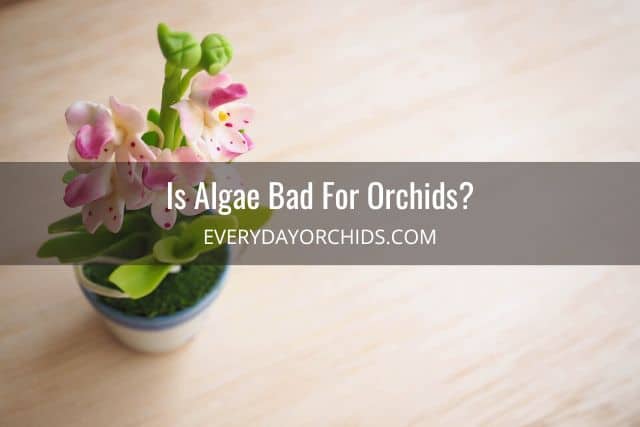
So the answer to this question is both yes and no. A little bit of algae is not bad for orchids, but excessive amounts of algae is bad for orchids.
If you see a little algae on the sides of the orchid pot or semi-hydroponics container, it won’t harm your orchids. It won’t hurt to just leave it if it looks like it is not affecting the orchid. It is not aesthetically pleasing, however, so if it bothers you, you can scrub it off and sanitize the container before repotting your orchid.
Many plant growers don’t like even a small amount of algae on their plants for several reasons. Algae competes with the plant for nutrients, can limit light reaching the roots, and can grow rapidly out of control. I’ll talk about each of these points in more detail below.
Competition For Nutrients
Algae does not outright harm orchids or plants, but in large amounts, it can compete with the plant for nutrients.
Note: If you see just a small amount of algae on the roots, this competition can actually be insignificant and will not cause long-term damage to your orchid.
Less Light Reaching Orchid Roots
Another thing to think about is lighting. If algae film is lining the inside of the clear orchid pot, it makes the pot opaque and less see-through. As a result, the algae can reduce the amount of light reaching the orchid roots.
Orchid roots can perform photosynthesis and harvest energy for the orchid. Less light means less photosynthesis.
Not a deal breaker, and certainly not a reason to panic, but just something to keep in mind when you have algae on your orchid pots, especially if you choose to leave the algae there.
When Is Algae A Problem?
Algae becomes a problem when your orchid roots or orchid pot are covered in algae. You may see this happen more often in semi-hydroponics situations. Excessive algae growth will occur when there is too much moisture, nutrients and light.
Algae grows quickly in ideal conditions. In severe cases, it can cover the entire orchid root, the inside of the potting container and/or the potting media itself.
In a semi-hydroponics or hydroponics situation, algae particles can easily break away and contaminate the water, causing it to become cloudy and dirty-looking.
When the algae is this extensive, it will compete with the plant for nutrients. Algae growth on the roots will decrease the roots’ ability to absorb water. Algae covering the interior of the orchid’s container will block light from reaching the roots.
In these cases, you may see stunted growth, fungal infections or disease, rot, pest infestations, and yellowing, wilted leaves. As algae continues to build up and older algae dies, it will start to smell, leading to other problems.
In this scenario, leaving algae on the roots and allowing algae to continue to grow is a bad idea. If you see extensive amounts of algae on the orchid roots, make an effort to get rid of the algae. I’ll go into more detail below on how to do that.
Can Algae Help Your Orchid Roots?
An argument can be made for leaving algae on orchid roots. Some say that algae helps oxygenate the root environment and can actually be beneficial. Algae performs photosynthesis too and releases oxygen during the process.
However, the research on this is minimal and I would not use this as a reason to leave the algae on your plant. Like I said before, with the right growing conditions, algae can grow and spread quickly. As with orchid pests, you want to tackle the problem sooner than later, before it gets out of hand.
Why Does Algae Smell Bad?
Generally, healthy, living algae doesn’t smell. Or at least, when I found algae on my orchid pot, it didn’t have a scent.
Anytime you have a foul odor coming from your orchid pot or roots, alarm bells should be going off.
A foul odor is a sign of dead or decaying algae. I repeat, if the algae smells bad, it is because it is dead or decaying. You need to address it right away.
In general, bad smells can indicate decomposition, rot, or an underlying bacterial or fungal infection. Whenever you have a foul odor coming from your orchid or the potting media, it warrants further investigation.
What To Do If You Find Foul Smelling Algae On Your Plants
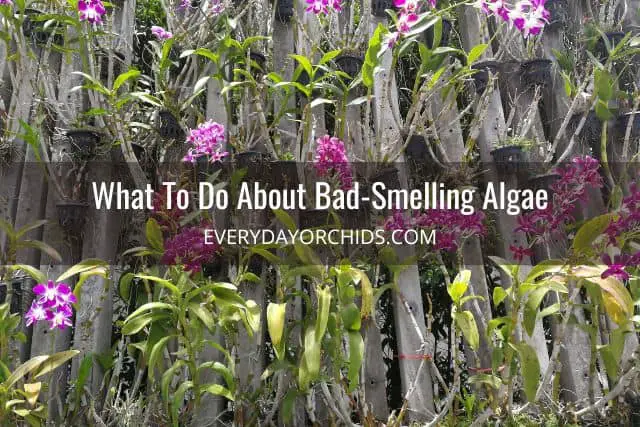
If the algae on your orchids or plants starts to smell, you will have to take steps to remove the rotting algae.
Bad-smelling algae is a sign of rot and decay. Leaving dead or decaying algae in the pot alongside your orchid will expose your plant to further disease, infections and rot.
However, what you will do next depends on whether your orchid is potted or mounted. I’ll go over how to approach each of those scenarios next.
Potted Orchids
If your orchid is potted and you smell a foul odor coming from the pot, you will need to unpot your orchid to investigate.
Gently unpot the orchid and remove the old potting media. Throw away the old potting media. Do not reuse it.
Inspect the roots and prune off any dead or rotting roots using sterilized gardening shears.
Take this opportunity to clean off any dead or dried up algae from the roots as well. I would recommend gently washing the remaining orchid roots under running water to remove as much algae as you can. Wear waterproof gloves such as dishwashing gloves to carefully work the algae off the roots.
Afterwards, apply a fungicide/bactericide such as Physan20 to kill off any lingering pathogens. Then, repot the orchid into a clean, sterilized pot using fresh, new potting media.
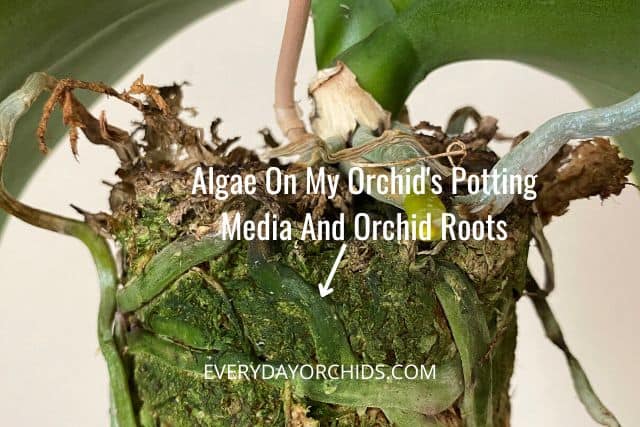
Mounted Orchids
If your orchid is mounted or in a situation where it may be difficult to unpot or remove, then you can try applying Physan20 to the roots, surrounding potting media and the mount.
Dilute 1 teaspoon of Physan20 into 1 gallon of water and apply this to all affected areas. Let the Physan20 sit for an hour or so, then rinse off with clean water.
Make sure you have good airflow to the orchid roots and reduce any excessive moisture. You may also need to do more than one application of Physan20 (one per week) before the problem starts to go away.
If there is a lot of algae on the potting media, you should try to replace or change out the potting media if you can do so without disturbing the orchid.
What If The Orchid Mount Is Rotted?
If the algae situation is severe and has caused the mount to rot, you will not be able to save the mount. Merely applying Physan20 to the orchid mount will not be enough to fix the problem.
Instead, you will need to remove your orchid from the mount and remount it to a new board. Leaving your orchid on this infected mount will be detrimental in the long run. Pathogens on the board can transfer to the orchid and cause illness and disease.
Removing An Orchid From A Mount
To remove the orchid from the mount, soak the wooden board, orchid roots and all, in a bucket of warm water for at least 30 minutes. This will soften the roots and help you detach them from the mount.
You will need to work slowly and carefully, prying off one root at a time. Once you have freed your orchid, then you can remount it to a clean, new mounting board.
This may go without saying, but use new sphagnum moss (hopefully heat-treated by the manufacturer!) to support your orchid on the new mount. Don’t reuse the old sphagnum moss, as it likely has algae and algae spores.
Final Thoughts
Finding algae on your orchid’s potting media, roots or pots isn’t the end of the world. Algae growth occurs because your orchid or plant has the right combination of water, light and nutrients in it’s growing area. In many cases, a little algae won’t hurt your orchid.
If, however, the algae begins to smell or the overgrowth of algae begins to stunt orchid growth, you will need to address it as soon as possible. Bad-smelling algae is often a sign of rot or decay, which can negatively affect your orchid’s overall health. Hope this helps!
If you enjoyed this article, please pin it and share!
